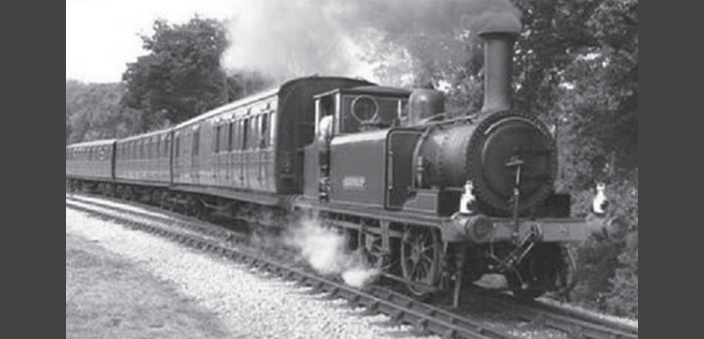As British railway historian Ian J. Kerr often puts it – No railroads, no India. The railways arrived in India in the mid-nineteenth century. Before the iron horse arrived, transportation modes here were primitive. Generations stayed in one place and followed traditions and practices for ages. Till then, the major form of transport were palkhis to transport people and animals like horses for rides and to ferry goods. The animals changed as per the region with elephants, camels and oxen. Water transport was another popular form of transport with most rivers then navigable, and ports being important trading points.
Cotton the catalyst
Cotton had been one key raw material that the British textile mills required and this was being procured from India. As the state of transport here was poor, by the time the cotton reached the shores from the country’s interiors (where it grew), it was badly damaged in the long and slow transport process that involved bullock carts and animal packs. When there was drought and famine, bullock transport was further unreliable and there were instances when ships had to be kept waiting at the ports for goods that never arrived, as animals were either too weak or died on the way when they were driven all the way from the country’s interiors.
With such slow modes of transport, dispersal of the military was also becoming a problem. It was felt that organising and dispersing the growing native population and faster deployment of troops could be better handled by a faster means of transport. The railways that were a contemporary and improving technology in Britain by then were thought to be an answer, and a proposal to build a railway line in India was first floated by Lord Dalhousie in 1843.
(Note: Technically, a small standard-gauge industrial railway, called the Red Hill Railroad, with rotary steam locomotives, had been started as far back as 1836 in Madras, ferrying material for road building. Though the network shut down by 1845, it could qualify as the first ever rudimentary railway in India.)
And thus chugged the first passenger train in Asia
But Dalhousie’s plan for was for proper passenger runs. With encouragement from Bombay Governor George Arthur, a civil engineer named George T. Clark prepared tentative plans for a line from Bombay town. Clark, who had worked with Isambard Brunel, had come down to India in 1842 and ended up proposing an 89 kilometers of rail line from Bombay to the foot of the Western Ghats. (Isambard Kingdom Brunel who lived from 9 Apr 1806-15 Sept 1859, was a British civil engineer who built bridges, steamships and dockyards including the first major British railway, the Great Western Railway; a series of steamships, including the first propeller-driven transatlantic steamship, revolutionising transport and engineering.)
The plans worked out well and on 16 April 1853, along the reclaimed islands of Bombay ran the first passenger train in the continent of Asia. From a small wooden platform at Bori Bunder, all the way 21 miles ahead to Thane. From here, the railways spread far and wide never to look back. The East Indian Railway steamed out of Howrah a year later in 1854, and trains of the Madras Railway Company two years later in 1856. By 1880, the railway network had a route mileage of about 14,500 km (9,000 miles), connecting the port cities of Bombay, Madras and Calcutta. One hundred and sixty-two years later today, Indian Railways, the premier transport organisation of India is the largest rail network in Asia, and the world’s second largest under one management, running 11,000 trains everyday with 6,853 railway stations.
Here is a prime example of our respect for the age-old British legacy that has been inherited by us, preserved and continued.
The first train
The train indicator at Mumbai CST station says 3:38pm Thane. It is a sunny April afternoon and the train is not much crowded at that hour in Mumbai. It is a “slow” train and reaches its destination Thane about 34 km away at 4:34 pm, trundling along 18 stations of the Central Railway on the way in exactly 56 minutes. So? There are local trains every three to four minutes and countless passengers along Mumbai’s rail network, what’s the big deal about this train ride?
Well. The Mumbai suburban railway caters to seven million passengers every single day. The two administrative zones of Western and Central Railway divide the crowd with the Western Railway (WR) Mumbai ferrying 3.5 million passengers and the Central Railway’s (CR) Mumbai division ferrying 4.0 million of them. While the WR runs 1,305 services, the CR runs 1,600 of them, making the Mumbai suburban railway one of the world’s densest rail passenger networks.
The 3:38 pm Mumbai CST-Thane train is just one of these. But few would know that the story of Indian Railways begins with this train. On a similar April afternoon, about 162 years ago in 1853, India’s first passenger train had made its debut from the same station, to the same destination and at the same time. It was an era when railways were a novelty and trains were magical demons. When the first train left from Bori Bunder station (now Mumbai CST) to Thane, the entire town had come down to witness the wonder, with the government declaring the day as a public holiday. Crowds thronged all around the way to watch the wonder pass by. The first train in Asia had started from Bori Bunder to Thane, a distance of about 34 kms, at 3:35pm. It had reached Thane in 57 minutes. The Central Railway Mumbai, to mark this first run, still maintains a Thane-bound train at the similar time, preserving the legacy.
Things have changed though. The original Bori Bunder station was a few hundred metres away in the north from today’s Mumbai CST, the original train ran at 3:35pm, but today’s train runs at 3:38pm adjusting to the huge timetable. But the time taken today with 18 stations is almost the same. It was after this first run that the railway network in this country never looked back. It went on to expand further and further to complete 14,500 kms in the next 27 years.
Bullock cart owners’ protest
The first month of the first-ever railway was a runaway success. Regular runs of the train had begun from 18 April 1853, and by 30 April 1853, the trains had ferried 21,922 passengers, earning ` 9,109, three annas and eight paise! The next month, in May 1853, the figure rose to Rs. 40,071, and by December 1853 to Rs. 61,413.73 Yet, even as the rail network took root, there was resistance from an unlikely quarter. Bullock-cart owners took up a fight with the railways. They were irate, not only because of the dwindling number of passengers, but also because of falling cargo supply. The railways were ferrying everyone and everything! To take control of the situation, bullock-cart owners began charging a fixed rate from the hinterlands to Bombay; it now made little economic sense for passenger traffic and cargo to disembark midway at railway stations. The bullock-cart owners’ plan was a success and proved to be a headache for the railway managers.
The railway budget
The much-hyped railway budget that the Indian government presents every year is another such British legacy. Only a few know that the concept of having a separate rail budget is completing 83 years this year. The story of India’s separate railway budget is equally fascinating as that of the subcontinent’s railway line. Multiple companies, private lines and a scattered system – that’s how Indian Railways was in the 1920s. As the railways grew in the sub-continent, the issue of control and management by the government started becoming a complicated task.
town had come down to witness the wonder, with the government declaring the day as a public holiday. Crowds thronged all around the way to watch the wonder pass by.The first train in Asia had started from Boree Bunder to Thane, a distance of about 34 kms, at 3:35pm.
To study the issue and recommend a solution, the government, in 1921, appointed a 10-member panel called the East India Railway Committee. As it was chaired by British “railway scientist” Sir William Mitchell Acworth (1850-1925), it came to be known as the Acworth Committee.
The committee recommended a unified management of the entire network and that “the railways should have a separate budget of their own and assume responsibilities of their income and expenditure”.
Historian on colonial railways in India and professor of history at the University of Manitoba, Ian J. Kerr describes the Acworth Committee as “one of the most influential of the many committees that inquired into railroad matters during the colonial period”.
The government accepted the report in 1924, and the railway finances were separated from the general government finances the same year, leading to an independent railway budget — a practice followed to this year.
The legacy of the station roundels
This is a small, but important legacy. The popular blue and red roundel that is ubiquitous at Indian Railway stations is also a British legacy. The signage also has a glorious story. The roundel was originally used by the London General Omnibus Company, London’s principal bus operator between 1855 and 1933. In 1908, the Underground Electric Railways Company of London first used the solid red circle behind station name boards. London Transport chief Frank Pick, who was initially given responsibility for London Underground’s publicity in 1908, made a disc out of the red roundel, asking designer Edward Johnston to develop and register it as a trademark. Johnston redesigned it and the red disc with blue station name became a popular signage throughout the system. The 100th anniversary of the roundel was celebrated in 2008. The design found its way to Indian rail stations, not clear which year, but is very much in use, oblivious to Pick and Johnston’s contributions.
The Up and Down
Well, the Up and Down that we see in railway timetables today is yet another English practice. Railway directions are usually described as up and down, with up being towards a major location, the zonal or divisional headquarters. Since British trains run on the left, now followed in India, the up side of a line is on the left when proceeding in the up direction. The original idea has come down from the days of mine railways when trains would run up the hills to the mines, and down to the ports. Tracks were laid from mines to docks. Normally, the mines were inland and higher than sea level, so the coal was transported down to sea level where the docks were.
The National Railway Museum
The most important repository of British legacy and heritage is the National Railway Museum (NRM) at New Delhi. Opened on 1 February 1977, the NRM is located over 10 acres of land with both indoor and outdoor exhibits. There are many unique exhibits that had once operated in various parts of the country, India’s first electric train, various iconic locomotives, Patiala State Monorail Trainways, Fairy Queen, the world’s oldest working steam locomotive in operational service, Morris Fire Engine, the saloons of Prince of Wales, the Maharaja of Indore, the Maharaja of Mysore and various such exhibits. It also has a library and research facility.
More excerpts of legacy and metaphors
Today, at the site where the old Bori Bunder Station once was – somewhere near the electric locomotive shed, close to signals S-54 and S-48 – Victoria Terminus-bound trains, fast and slow, halt before entering the mega terminus. Operationally, this is to get a ‘line clear’ and a platform signal; metaphorically, this acts as a mark of respect for the original Bori Bunder Station.
India’s first locos
The first locos remained in service for quite some time and the last one was seen 100 years after it was first put to use; it was commemorated at the centennial year of the Indian railways.


